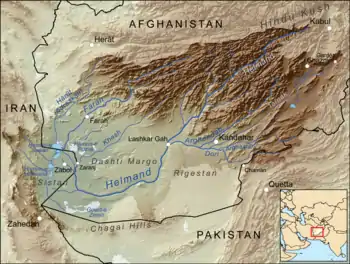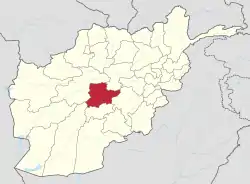Helmand River
The Helmand River (also spelled Helmend, or Helmund, Hirmand; Pashto/Persian: هیرمند / هلمند; Greek: Ἐτύμανδρος (Etýmandros); Latin: Erymandrus) is the longest river in Afghanistan and the primary watershed for the endorheic Sistan Basin.[1]
| Helmand River | |
|---|---|
 Map of the Helmand River drainage basin | |
 Map of the Helmand River drainage basin | |
| Location | |
| Countries | Afghanistan and Iran |
| Physical characteristics | |
| Source | |
| • location | Hindu Kush mountains |
| Mouth | |
• location | Lake Hamun |
| Length | 1,150 km (710 mi) |
| Basin size | Sistan Basin |
| Basin features | |
| Tributaries | |
| • left | Arghandab River |
| • right | Khash River Chagay River |
Etymology
The name comes from the Avestan Haētumant, literally "dammed, having a dam", which referred to the Helmand River and the irrigated areas around it.[2]
Geography
The Helmand River stretches for 1,150 km (710 mi). It rises in the Hindu Kush mountains, about 40 km[3] west of Kabul (34°34′N 68°33′E), passing north of the Unai Pass, in the eastern proximities of Hazarajat, in Behsud, Maidan Wardak, flows west to Daykundi and Uruzgan. It crosses south-west through the desert of Dashti Margo, to the Sistan marshes and the Hamun-i-Helmand lake region around Zabol at the Afghan-Iranian border (31°9′N 61°33′E). A few smaller rivers such as Tarnak and Arghandab flow into Helmand.[4]
This river, managed by the Helmand and Arghandab Valley Authority is used extensively for irrigation, although a buildup of mineral salts has decreased its usefulness in watering crops. For much of its length, Helmand is free of salt.[5] Its waters are essential for farmers in Afghanistan, but it feeds into Lake Hamun and is also important to farmers in Iran's southeastern Sistan and Baluchistan province.
A number of hydroelectric dams have created artificial reservoirs on some of the Afghanistan's rivers including the Kajakai on the Helmand River. The chief tributary of the Helmand river is the Arghandab River (confluence at 31°27′N 64°23′E) which also has a major dam north of Kandahar.
History
The Helmand valley region is mentioned by name in the Avesta (Fargard 1:13) as the Aryan land of Haetumant, one of the early centres of the Zoroastrian faith in areas that are now Afghanistan. However, by the late first millennium BC and early first millennium AD, the preponderance of communities of Hindus and Buddhists in the Helmand and Kabul valleys led to Parthians referring to it as White-India.[6][7][8] [9]
Notes
- "History of Environmental Change in the Sistan Basin 1976 - 2005" (PDF). Retrieved 2007-07-20.
- Jack Finegan. Myth & Mystery: An Introduction to the Pagan Religions of the Biblical World. Baker Books, 1997. ISBN 0-8010-2160-X, 9780801021602
- "HELMAND RIVER i. GEOGRAPHY – Encyclopaedia Iranica". www.iranicaonline.org. Retrieved 2020-06-14.
- "Helmand River | river, Central Asia". Encyclopedia Britannica. Retrieved 2020-06-15.
- "Helmand River". www.cawater-info.net. Retrieved 2020-06-16.
- http://parthia.com/doc/parthian_stations.htm
- Vendidad 1, at Avesta.org
- Beyond is Arachosia, 36 schoeni. And the Parthians call this White India; there are the city of Biyt and the city of Pharsana and the city of Chorochoad and the city of Demetrias; then Alexandropolis, the metropolis of Arachosia; it is Greek, and by it flows the river Arachotus. As far as this place the land is under the rule of the Parthians.
- Avesta, translated by James Darmesteter (From Sacred Books of the East, American Edition, 1898
References
- Various authors. "HELMAND RIVER". Encyclopædia Iranica (Online ed.). United States: Columbia University.
- Frye, Richard N. (1963). The Heritage of Persia. World Publishing company, Cleveland, Ohio. Mentor Book edition, 1966.
- Toynbee, Arnold J. (1961). Between Oxus and Jumna. London. Oxford University Press.
- Vogelsang, W. (1985). "Early historical Arachosia in South-east Afghanistan; Meeting-place between East and West." Iranica antiqua, 20 (1985), pp. 55–99.
External links
| Wikimedia Commons has media related to Helmand River. |
